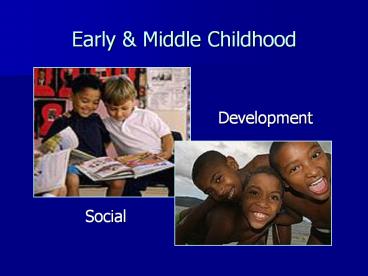Early - PowerPoint PPT Presentation
Title:
Early
Description:
88% of children (more boys) that watched aggressive model, imitated behavior... Socially competent, athletic 'tough' boys, poor students ... – PowerPoint PPT presentation
Number of Views:107
Avg rating:3.0/5.0
Title: Early
1
Early Middle Childhood
Development
- Social
2
Aggression
- Instrumental
- Common in preschoolers,
- but decrease with age
- Hostile overt relational
- Overt increases 4-7, then declines
- Relational increases
- Gender differences?
Why and when are children aggressive?
3
Bobo Doll Experiment (Albert Bandura)
- Participants 36 boys girls M age 4.5
- Method
- Watched video of either
- Non-aggressive model
- Aggressive model
- Frustration period
- Testing session
- Number type of aggressive acts were recorded
4
(No Transcript)
5
Bobo Doll Experiment (Albert Bandura)
- Results
- 88 of children (more boys) that watched
aggressive model, imitated behavior - in exactly the same way!
- More likely to play aggressively, even if not
modeled - 8 months later, 40 reproduced the aggressive
behavior
What does this say about violence on TV?
6
(No Transcript)
7
Aggression Summary
- Aggressive families breed aggressive children
- View the world from a violent point of view
- Violent media is particularly influential in
early childhood because - Susceptible to models that admire/respect
- Lack of perspective taking, centration, etc.
8
Friendships in Childhood
- Types of play
- Early someone you play with, who likes you
- Limit dont describe long-term qualities
- Middle trust becomes defining feature
Think of your first friend why were they a
friend?
9
(No Transcript)
10
Peer Groups in Middle Childhood
- Social unit that shares values, similar standards
for behaviors, has a social structure - Proximity
- Similarity
- Moderately stable peer culture
- Vocabulary, dress codes, hang out spots
How do peer groups become organized?
What makes up a peer groups culture?
11
Peer Acceptance
How could we measure peer acceptance?
- Sociometric technique
- Name 3 children you would like to play with most
3 least. - Social behavior is primary determinant
- Powerful predictor of current later adjustment
- Four major categories of peer acceptance
- 66 fit categories, 33 are average
What do you think determines peer acceptance?
12
Popular children
- Many positive votes
- Popular-prosocial
- Socially academically competent
- Good adjustment
- Popular-antisocial
- Socially competent, athletic tough boys, poor
students - Likeability offers protection from maladjustment
13
Rejected children
- Many negative votes
- Rejected-aggressive
- Socially hostile conflicts hyperactive
inattentive - Poor academically at risk for delinquency
- Rejected-withdrawn
- Socially awkward passive anxiety
influences academics - At risk for vicimization by bullies
14
(No Transcript)
15
Bullies Victims
- Statistics 10 bullied on weekly basis
- Who does the bullying?
- Older children bully younger
- Boys bullied by boys if girls, 60 bullied by
boys - Mostly rejected-aggressive or popular antisocial
- Are victims always passive?
- Proactive victims pick fights get angry easily
- Long-term consequences?
- Bullies gt criminals
- Victims gt low self-esteem, depression
16
Controversial children
- Many positive negative votes
- Socially hostile, but engage in prosocial
behaviors - Relatively happy comfortable relationships
Neglected children
- Almost no votes either way
- Low rates of social interaction shy
- Relatively well-adjusted
17
Child Rearing Styles
18
Child Rearing Styles
- Warm attentive
- Reasonable demands, consistently explains
- Allows appropriate decision making
- Outcome
- Happy
- Self-confident
19
Child Rearing Styles
- Cold rejecting
- Coercive criticizing demands
- Makes decisions for child
- Outcome
- Anxious unhappy
- Hostile reactions
20
Child Rearing Styles
- Warm, but overly indulgent
- Few or no demands
- Allows decision making before ready
- Outcome
- Immature
- Impulsive less persistent
21
Child Rearing Styles
- Emotionally detached withdrawn
- Few or no demands
- Indifferent to decision making
- Outcome
- Poor emotion control
- Low achievement delinquency
Neglect!
22
In-Class Assignment 5
- The purpose of this assignment is to give you
practice identifying and distinguishing between
Baumrinds child-rearing styles.
23
(No Transcript)
24
Parental Relationships in Childhood
- Major developments
- Amount of time with parents decline in middle
childhood - Not ready for complete independence
What type of household did you grow up in?
- ¼ of children in single-parent
household - For an average of 5 years
25
Divorces Influences on Children
- Age the younger the child, the more difficult
- Blame themselves
- Fear of abandonment separation anxiety
- Fantasize about reunion
- Temperament
- Difficult children have most problems
- Sex
- Girls cry withdraw boys act out
- Boys have most difficulty in mother-custody homes
- School problems greater for boys
26
Long-term consequences?
- Improved adjustment by 2-years after divorce
- Some problems
- Increased sexual activity in adolescence
- More likely to divorce in adulthood
- Positive adjustment most likely when
- Parent adopts authoritative style
- Boys are placed with fathers
Low-conflict, single-parent household better than
stressed, high-conflict intact family!































